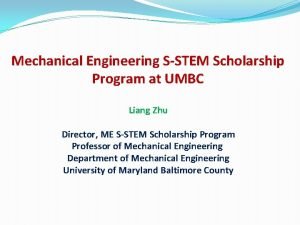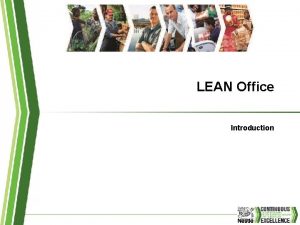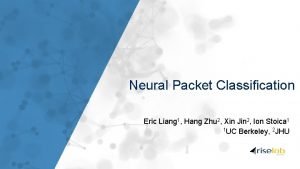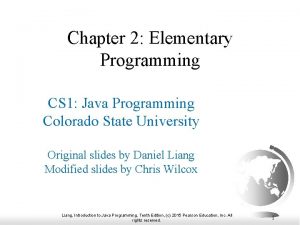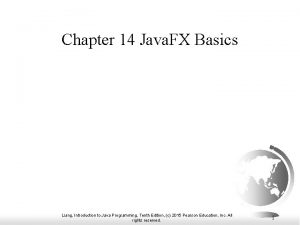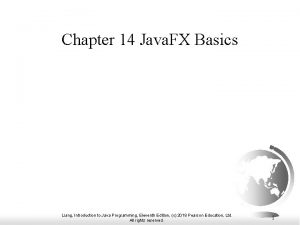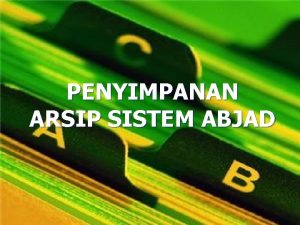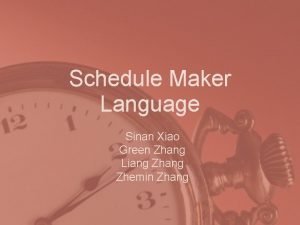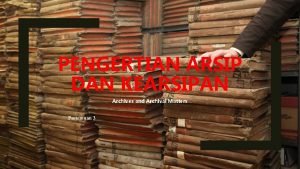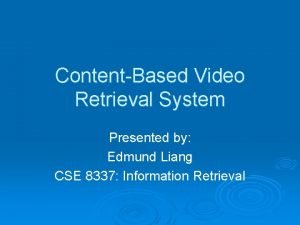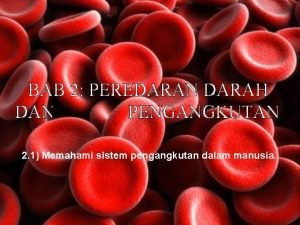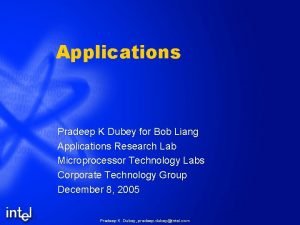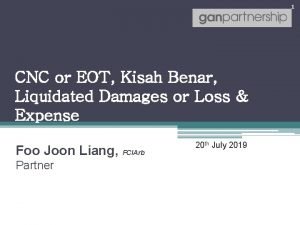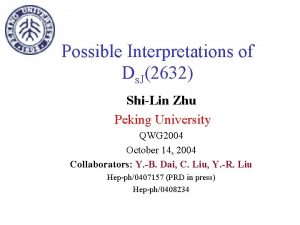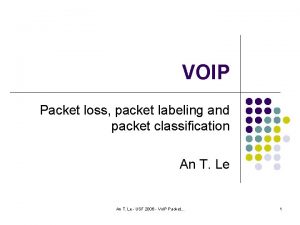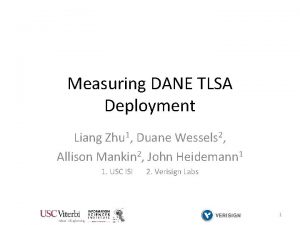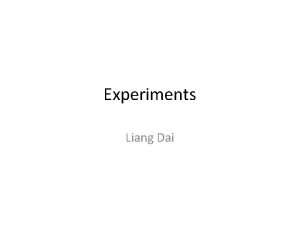Neural Packet Classification Eric Liang 1 Hang Zhu



























![Intuition N 3 action sampled; update tree; repeat until done FCNet([256, 256]) Action Distribution Intuition N 3 action sampled; update tree; repeat until done FCNet([256, 256]) Action Distribution](https://slidetodoc.com/presentation_image_h/0d5111aa03a90612c178e2a142e1183b/image-28.jpg)



- Slides: 31

Neural Packet Classification Eric Liang 1, Hang Zhu 2, Xin Jin 2, Ion Stoica 1 1 UC Berkeley, 2 JHU

Packet Classification ● Fundamental problem in computer networking ○ Building block for access control, Qo. S, defense against attacks Payload Header Payload Flow classification Src IP addr Dst IP addr Fiber optics Classifier (Rule Database) Predicate Action ----- Fiber optics 100 k rules or more! Src port # Dst port # Protocol type © 2018 RISELab Header Router / Firewall

Packet Classifier Example exact match any match range © 2018 RISELab 3

How hard is this problem? ● Similar to point-location problem ● Hard time-space tradeoff ○ O(log N) time and O(Nd) space ○ O(logd N) time and O(N) space ○ N: # of rules; d: # of attributes N ~= 100 k, d = 5 ● But harder: rules have priorities and can overlap in space Packet (matching R 1 and R 4) R 0 R 4 R 1 R 5 Y R 4 R 3 X © 2018 RISELab

Existing solutions ● Hardware-based (Ternary Content Addressable Memory) ○ Power and cost too high for large classifiers ● Software-based data structures ○ Build a multi-dimensional "classification tree" -- really a k-d index ● Goal of software-based solutions is to optimize for ○ Access time: number of DRAM accesses ○ Memory: total size of tree in memory ^ metrics we care about © 2018 RISELab

Twenty years of research in packet classification Hi. Cuts ('99), Hyper. Cuts ('03), Effi. Cuts ('10), Cut. Split ('15) ○ Engineered with hand-tuned heuristics targeting different objectives © 2018 RISELab

Our solution: Reinforcement Learning (RL) based move left +1 point ● Use RL to synthesize a classification tree ○ Deployable for real: build a tree in simulation => deploy that artifact directly to production © 2018 RISELab

TLDR; Neuro. Cuts algorithm ● Frames building packet classification trees as an RL environment ○ i. e. , game / sequential decision process ● Deep RL will lets us build significantly faster packet classifiers packet classification rules Train a Neuro. Cuts Agent with RL optimized tree data structure deploy artifact © 2018 RISELab

Why Reinforcement Learning? ● Existing solutions are based on greedy heuristics (e. g. , maximize split entropy, balance this space measure, etc. ). ● RL can do better than greedy approaches because it models the long-term outcomes of actions ● And can optimize directly for the end objective ● Historically, efficient RL formulation => super-human performance (e. g. , Alpha. Zero, Alpha. Star) © 2018 RISELab

Why not an end-to-end solution? packets decisions Model Infer which rule should be matched ? Pros: ○ maybe don't need to build a data structure at all Cons: ○ very large space of inputs => very hard to check model correctness ○ need a very large model to get good errors for large packet classifiers ○ packet inference costs too high (need decisions in hundreds of nanoseconds) ○ need specialized inference hardware © 2018 RISELab

Rules of the Game: (1) Node Cutting © 2018 RISELab

(2) Rule Partition: Avoiding Rule Replication © 2018 RISELab

Building classification trees ● Most existing algorithms build on these two actions: ○ Node cut ○ Rule partition ● Many heuristics on how to determine exactly how to cut / partition tree ○ i. e. , exploit the problem structure © 2018 RISELab

Adapting RL for building packet classifiers ^ defining this is the challenge © 2018 RISELab

First Attempt ● Naive MDP (Markov Decision Process) formulation of environment: ○ assume DFS order of building tree node-by-node ○ action is to cut or partition current node N 0 N 1 N 0 N 2 N 1 . . . action a 2 action a 1 N 3 state s 0 N 2 state s 1 N 4 state s 2 © 2018 RISELab reward = depth[tree] + alpha * -size[tree] N 5 state s. N

What are the challenges here? N 0 N 1 N 2 . . N 999999 N 1000000 N 1 N 0 N 2 Size of state grows with each step N 1 N 3 N 2 N 4 reward = -52 N 5 Rewards are delayed until end Need to learn to understand complex state + weak reward attribution => learning signal is too high variance © 2018 RISELab

Optimization #1 ● Node states are independent of parent or sibling nodes s 2 can be represented as a fixed-length vector describing N 3's bounding hypercube: N 0 N 1 N 3 N 2 N 4 state s 2 N 5 {Src. IPMin, Src. IPMax, Dst. IPMin, Dst. IPMax, Src. Port. Min, Src. Port. Max, Dst. Port. Min, Dst. Port. Max, Protocol. Min, Protocol. Max} © 2018 RISELab

Optimization #2 ● Building a tree is a branching decision process, not sequential MDP ● Calculate rewards not by summing over time, but agg. across tree branches N 0 N 1 N 3 Suppose this is the final state sn, how do we calculate the total teward (advantage) for the root node N 0? N 2 N 4 N 5 state sn © 2018 RISELab

Optimization #2 ● Building a tree is a branching decision process, not sequential MDP ● Calculate rewards not by summing over time, but agg. across tree branches Sequential Decision Process N 0 reward = -2. 1 N 3 N 4 reward = -2. 6 reward = -2. 8 N 5 N 2 done (reward = -3) reward = -2. 9 (temporally discounted) O(n) step delay between action and reward => action attribution is very weak (sparse reward problem) © 2018 RISELab

Optimization #2 ● Building a tree is a branching decision process, not sequential MDP ● Calculate rewards not by summing over time, but agg. across tree branches Branching Decision Process N 2 done (reward = -1) N 0 reward N 1 = min(rchild) - 1 = -3 reward = min(rchild) - 1 = -2 between O(logn) delay action and reward © 2018 RISELab N 3 done (reward = -1) N 4 done (reward = -1) N 5 done (reward = -1)

Defining the Learning Problem Action space: Either Cut or Partition Cut: choose dimension to cut, how many pieces to cut into Partition: specify heuristic to use, or dimension and threshold Observation space: Encoding of node state (binary string) Encoding partitioning state (binary string) Encoding of allowed actions mask (binary mask) © 2018 RISELab

Implementation Chose Proximal Policy Optimization (2017), but there are many reasonable choices of algorithm Used parallel off-the-shelf PPO implementation from RLlib (ICML '18) © 2018 RISELab

Evaluation on Class. Bench ● Standard benchmark for packet classifier performance ● Synthetic packet classifiers ranging from 1000 to 100 k rules in size, based on ○ Access control list (ACL), ○ Firewall (FW), ○ IP chain (IPC) rule sets ● Compare Neuro. Cuts against 521 citations ○ Hi. Cuts ○ Hyper. Cuts 625 citations ○ Effi. Cuts 172 citations ○ Cut. Split 8 citations © 2018 RISELab

Classification time Time-Optimized Neuro. Cuts Classifier name © 2018 RISELab

Time-Optimized Neuro. Cuts: Does it scale? Summary: 18% median time improvement over all baselines. Up to 2 x better. © 2018 RISELab

Space-Optimized Neuro. Cuts Summary: up to 3 x better memory over all baselines; Cut. Split somewhat better at median. © 2018 RISELab

Leveraging Existing Heuristics: Neuro. Cuts + Effi. Cuts Up to 10 x space improvement building on Effi. Cuts. Don't lose anything in time. © 2018 RISELab
![Intuition N 3 action sampled update tree repeat until done FCNet256 256 Action Distribution Intuition N 3 action sampled; update tree; repeat until done FCNet([256, 256]) Action Distribution](https://slidetodoc.com/presentation_image_h/0d5111aa03a90612c178e2a142e1183b/image-28.jpg)
Intuition N 3 action sampled; update tree; repeat until done FCNet([256, 256]) Action Distribution π(a|s) nodes at level Encoded current node: s = 010001. . . 11000101 dim=[0. 3, 0. 1, 0. 2, . . . ] num=[0. 05, 0. 7, 0. 1, . . . ] type=[0. 1, 0. 9] color = dimension of node split level of tree © 2018 RISELab

nodes at level Stochastic policy enables exploration level of tree ● stochastic policy means each rollout creates a different tree (above) ● allows agent to explore benefits of different choices ● can resample to get even better trees © 2018 RISELab

How does learning progress? ● Observation: for most classifiers, there exists a simple random distribution over actions that can generate a reasonable tree ● Can think of learning as happening in two phases: Phase I: going from poorly formed tree to learning a reasonable initial solution © 2018 RISELab Phase II: leveraging the modeling capacity of the neural network to converge to an optimized solution

Conclusion ● We introduce a tractable RL formulation of the packet classification problem ● Results beat state of the art in important dimensions: ○ 18% median improvement in time over all baselines ○ Up to 3 x improvement in time and space over all baselines ● Future: other data structures with complex performance heuristics ○ E. g. , Indexing for spatial databases Thanks! © 2018 RISELab
 Liang zhu umbc
Liang zhu umbc Lean office definition
Lean office definition Neurocuts
Neurocuts Richard seow yung liang
Richard seow yung liang Daniel liang introduction to java programming
Daniel liang introduction to java programming Zhuo shi wo li liang
Zhuo shi wo li liang Zhong han liang
Zhong han liang Yuanxing liang
Yuanxing liang Amber liang
Amber liang Liang fontdemo.java
Liang fontdemo.java Liang fontdemo.java
Liang fontdemo.java Penyimpanan arsip dengan sistem abjad
Penyimpanan arsip dengan sistem abjad Randy liang
Randy liang David teo choon liang
David teo choon liang How was ma liang like
How was ma liang like Zong-liang yang
Zong-liang yang Liang jianhui
Liang jianhui Sinan xiao
Sinan xiao Chia liang cheng
Chia liang cheng Fungsi pembagian laba
Fungsi pembagian laba Zong-liang yang
Zong-liang yang Siemens sans bold
Siemens sans bold Dr liang hao nan
Dr liang hao nan Pengertian arsip menurut para ahli
Pengertian arsip menurut para ahli Anticorps anti nucléaire moucheté 1/160
Anticorps anti nucléaire moucheté 1/160 Kathleen liang
Kathleen liang Edmund liang
Edmund liang Laluan darah beroksigen dari peparu ke aorta
Laluan darah beroksigen dari peparu ke aorta Dr pradeep dubey
Dr pradeep dubey Diana liang faa
Diana liang faa Cnc in construction contract
Cnc in construction contract Ds peking
Ds peking
